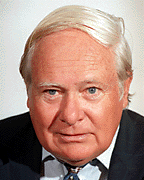
| Contents | Jump To Table 1 |
Next
Article |

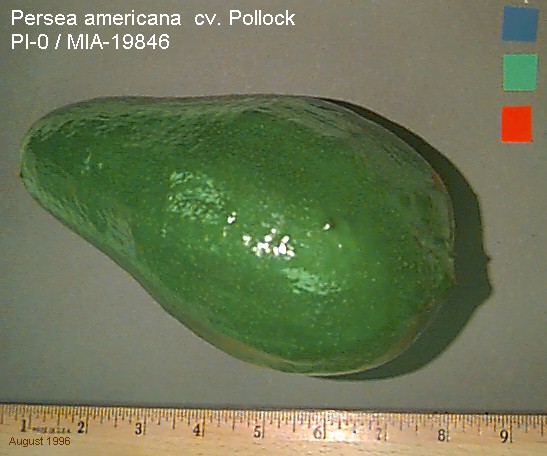
Persea americana 'Pollock' |
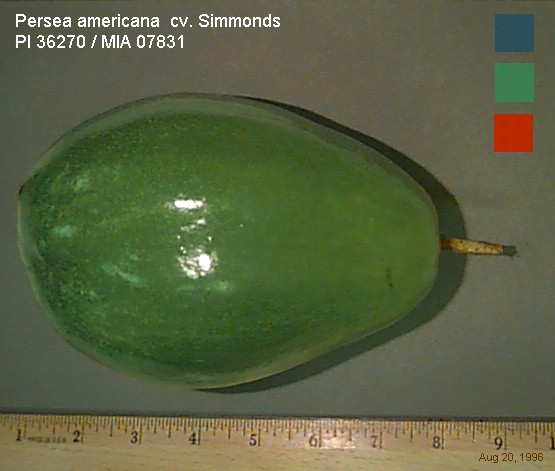
Persea americana 'Simmonds' |
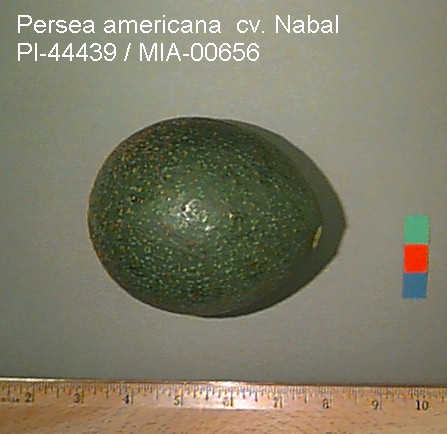
Persea americana 'Nabal' |
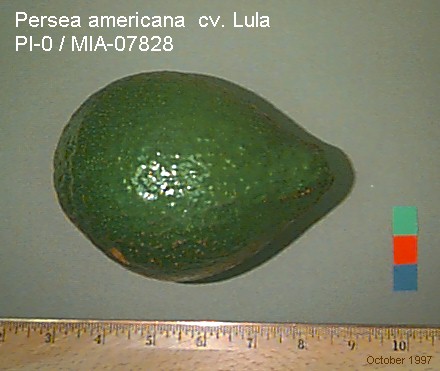
Persea americana 'Lula' |
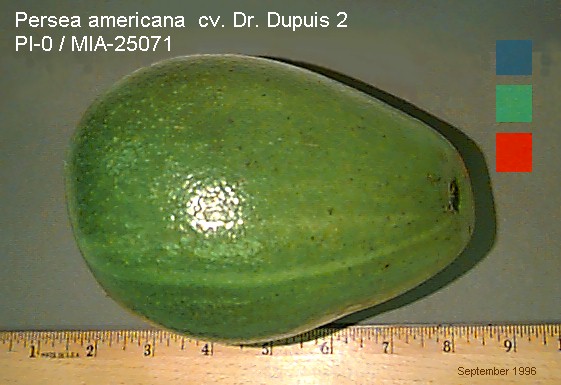
Persea americana 'Dr. Dupuis 2' |
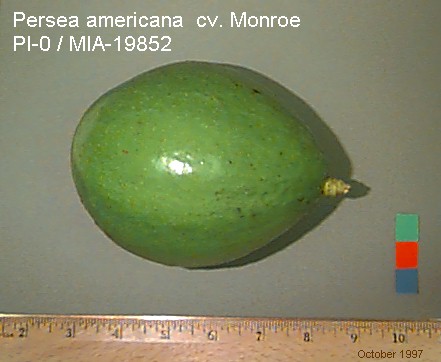
Persea americana 'Monroe' |
| Date Sent |
Sent To |
Material
Sent |
| 26 Oct 33
|
Island of Reunion |
Seeds: various cultivars. |
| 28 Aug 33 |
Quangtri, Vietnam |
Seeds: Pollock. |
| 14 Feb 34 |
Jamaica (Dept. of Agr.) |
Plants: Butler, Collinred B, Collinson,
Dunedin, Gottfried, Itzamna, Kanan seedling, Nabal, Trapp. |
| 7 Nov 36 |
Holguin, Cuba |
Scions: Collinred B. |
| 21 Jun 37 |
Dr. R. W. Hodgson UCLA, CA |
Plants: Arue. |
| 21 Jun 37 |
Dr. H. P. Traub USDA, Orlando, FL |
Plants: Arue. |
| 28 Dec 37 |
Dr. R. W. Hodgson UCLA, CA |
Plants: Seedless (Costa Rica), Small
seeded (Costa Rica). |
| 8 Jun 38 |
Mrs. I. B. Krome Homestead, FL |
Plant: Arue. |
| 8 Jun 38 |
USDA Plant Inspection
House, Wash, DC |
Seeds (40 WI) for stocks. |
| 26 July 38 |
USDA Plant Inspection
House, Wash, DC |
Seeds 50 for stocks. |
| 17 Dec 38 |
Dr. H. P. Traub, USDA Orlando, FL |
Plants: Small-seeded (Costa Rica). |
| 28 Dec 38 |
Dr. H. P. Traub, USDA |
Plant: Seedless (Costa Rica). |
| 29 May 40 |
H. M. Matheson, Miami, FL |
Plants: Small-seeded (Costa Rica). |
| 12 Jan 42 |
US Plant Introd. Gard. Glenn Dale, MD |
Seeds. |
| 10 Apr 44 |
US Plant Introd. Grad. Glenn Dale, MD |
Scions: Booth 1, 7 & 8, Collinred
B (Fairchild), Collinson, Dickinson, Fuchs, Hickson, Itzamna, Linda,
Lula, Nabal, Peterson, Pinelli, Pollock, Schmidt, Simmonds, Taft, Taylor,
Trapp, Wagner, Waldin, Winslowson. |
| 27 Jan 50 |
Univ. of Miami Coral Gables, FL |
Plants: Arue, Biscayne, Capac. |
| 28 Feb 50 |
F. L. Steely Homestead, FL |
Plant: Arue. |
| 14 Mar 50 |
E. W. Brown Pierson, FL |
Plants: Arue, Biscayne |
| 5 Sept 50 |
E. H. Sauerbrey
US Botanic Gard., Wash DC |
Plants: Biscayne. |
| 25 Oct 50 |
V. V. Virrick Coconut Grove, FL |
Scions: Tela. |
| 7 Feb 51 |
F. M. Henderson Princeton, FL |
Scions: Arue. |
| 15 Feb 51 |
W. F. Herman S. Miami, FL |
Scions: Arue. |
| 21 Feb 51 |
Dr. F. E. Hasty Coral Gables, FL |
Scions: Arue. |
| 7 May 51 |
J. J. Hawkins Miami, FL |
Scions: Arue. |
| 8 May 51 |
F. M. Henderson Princeton, FL |
Plant: Arue. |
| 6 Nov 51 |
I. D. Ebersole Homestead, FL |
Scions: Biscayne. |
| 17 Dec 51 |
H. F. Winters, USDA Mayagüez, PR |
Scions: Arue. |
| 17 Mar 54 |
H. F. Winters, USDA Mayagüez, PR |
Scions: Arue |
| 30 Jun 54 |
Mrs. J. W. Lowe Homestead, FL |
Scions: Arue, Capac. |
| 19 July 55 |
L. Whitlock Miami, FL |
Scions: Arue |
| 22 Sept 55 |
A. J. Dubreuil Miami, FL |
Scions: Arue |
| 28 Sept 56 |
US Plant Insp. House Wash, DC |
Seeds |
| 8 Oct 57 |
H.F. Winters, USDA Glenn Dale, MD |
Seeds |
| 20 Dec 57 |
APO 74 San Francisco, CA |
Seeds: Booth (no number), Collinson, Herman,
Hickson, Kanan, Lula, Simpson. |
| 23 Sep 58 |
US Plant Introd. Sta. Chico, CA |
Seeds: Dade, Gottfried, Isham, Simmonds
sdlg, 3 W.I. sdlgs. |
| 22 Oct 58 |
US Plant Introd. Sta. Chico, CA |
Seeds: Costa Rican, Dickinson, Gottfried
sdlg, Kanan sdlg, Kayab, Lula, Tela, Tonnage, Waldin, 3 W.I. sdlgs. |
| 31 Oct 58 |
US Plant Introd. Sta. Chico, CA |
Seeds: Itzamna, Kanan, Simmonds sdlg,
Waldin, W.I. sdlg. |
| 12 Nov 58 |
US Plant Introd. Sta. Chico, CA |
Seeds: Booth 1, Booth 8, Lula, Taylor. |
| 7 Mar 59 |
Punjab Agric. Coll. Lyallpur, Pakistan |
Scions: Booth 8, Lula, Waldin. |
| 1 Apr 59 |
Dr. G. A. Zentmyer U CA Riverside |
Seeds: Dunedin, Lula. |
| 4 May 59 |
Dr. B. O. Bergh U CA Riverside |
Scions: Ettinger. |
| 4 Aug 59 through 27 Aug 59 |
Dr. G. A. Zentmyer U CA Riverside |
Seeds: Arue, Capac, Cellon's Hawaii,
Cellon's Hawaii sdlg, Collins sdlg, Costa Rica, Gottfried,
Gottfried sdlg, Mexican sdlg 713-B, unidentified sdlg. |
| 4 Sept 59 |
US Plant Inspn House, for Pakistan |
Scions: Pollock, Waldin. |
| 30 Sept 59 through 3 Aug 60 |
Dr. G. A. Zentmyer U CA Davis |
Seeds: Butler, Capac, Cellon's Hawaii,
Cellon's Hawaii sdlg, Collinred sdlg, Collinred F-2
sdlg, Collinson, Dade, Gottfried sdlg, Kanan, Lamat, Lula, Manik, Peterson, Simmonds, Simmonds sdlg, Trappson, W.I. sdlg. |
| 2 Mar 61 |
Dr. C. W. Campbell U FL Homestead |
Scions: Cellon's Hawaii. |
| 24 Mar 61 |
Dr. G. A. Zentmyer U CA Davis |
Scions: Cellon's Hawaii, Cellon's Hawaii
sdlgs (4), Hawaii. |
| 3 Oct 61 |
Dr. G. A. Zentmyer U CA Davis |
Seeds: Cellon's Hawaii sdlg M6900. |
| 12 Jan 62 |
Hugo Bow Pahokee, FL |
Scions: Cellon's Hawaii sdlg, Tela. |
| 31 July 62 |
W.L. Ackerman US Plant Introd. Sta. Glenn Dale, MD |
Seeds: W.I. sdlg. |
| 16 Aug 62 through 16 Nov 62 |
Dr. G. A. Zentmyer U CA Riverside |
Seeds: Cellon's Hawaii, Cellon's Hawaii
sdlgs (3), Cellon's Hawaii M6900. |
| 15 Mar 63 |
H. F. Loomis Miami, FL |
Plants: Family. |
| 27 Sept 63 |
Judge G. T. Shannon Lakeland, FL |
Plant: Yon. |
| 14 Oct 63 |
F. Chawanonda Bangkok, Thailand |
Seeds: Collinson, Dade, Lula. |
| 20 Feb 64 |
R. R. Mason, Agric. Officer, Kowloon, Hong Kong |
Plants: Booth 8, Lula, Waldin. |
| 24 Feb 64 |
R. M. Bond St. Croix,
US Virgin Islands |
Scions: Arue, Arue sdlg 2-18. |
| 2 Mar 64 |
J. A. Austin Mandarin, FL |
Plants: Fuca, Tenerife. |
| 31 July 64 |
K.G. McIndoe Leesburg, FL |
Scions: Brooksville Mexican, Family, Nabal,
Taylor. |
| 21 Dec 64 |
Dr. E. O. Olson Weslaco, TX |
Scions: Brooksville, Mexican. |
| 11 Mar 65 |
Burt Colburn Homestead, FL |
Scions: Seedless Mexican. |
| 26 Apr 65 |
R.R. Mason, Agric. Officer, Kowloon, Hong Kong |
Plants: Booth 8. |
| 24 May 65 |
US Plant Insp. House Wash, DC |
Plants: Chapultepec Park (Mexico). |
| 11 Feb 66 |
J. W. Swain Inverness, FL |
Plants: Mexican sdlg, wild Guat. sdlg,
Taylor. |
| 18 Feb 66 |
US Embassy Dakar, Senegal |
Scions: Booth 7, Booth 8, Collinson, Lula,
Nabal, Peterson, Pollock. |
| 13 June 66 |
USAID Lagos, Nigeria |
Scions: Booth 8, Fuerte, Itzamna, Nabal,
Pollock, Taylor. |
| 13 June 66 |
US Embassy Dakar, Senegal |
Scions: Booth 7, Booth 8, Collinson, Lula,
Nabal, Peterson, Pollock. |
| 13 June 66 |
Plant Quarantine
Service Accra, Ghana |
Scions: Booth 7, Booth 8, Fuchs, Lula,
Monroe, Pollock, Ruehle, Taylor, Tonnage, Trapp, Waldin. |
| 12 Sept 66 |
USAID Lagos, Nigeria |
Scions: Booth 7, Booth 8, Fuchs, Lula,
Monroe, Pollock, Ruehle, Taylor, Tonnage, Trapp,
Waldin. |
| 12 Sept 66 |
Plant Quarantine
Service Accra, Ghana |
Scions: Booth 7, Booth 8, Fuchs, Lula,
Monroe, Pollock, Ruehle, Taylor, Tonnage, Trapp, Waldin. |
| 29 Nov 66 |
USAID Cotonou, Dahomey |
Scions: Choquette, Monroe, Pollock, Ruehle. |
| 9 Mar 67 |
S. Malo, U of FL Homestead, FL |
Scions: Capac, Dade, Duke, Dunedin, Egas,
Ettinger, Family, Isham, Manik, Seedless Mexican, Tamayo, Tela, Ward. |
| 17 Mar 67 |
D. F. Kiesau, Miami,
FL |
Scions (Collinred B (Fairchild). |
| 12 Apr 67 |
W.R. Llewellyn Asst County Agent Sanford, FL |
Scions: Collinson, High-elevation Guatemalan,
Winter Mexican, Yon. |
| 22 May 67 |
D.W. Levandowsky US Embassy, Santo Domingo, Dom. Rep. |
Scions: Nabal. |
| 12 Jun 67 |
Mrs. M. Davidson, Ministry of Agric. Kingston, Jamaica |
Scions: Choquette, Collinred B (Fairchild),
Ettinger, Fuchs, Ruehle. |
| 20 Jun 67 |
USAID Santo Domingo,
Dom. Rep. |
Scions: Booth 8, Dunedin,
Nabal. |
| 14 Sept. 67 |
A.L. Núñez Caracas, Venezuela |
Scions: Hass, Fuerte, Nabal. |
| 18 Sept 67 |
US Plant Introd. Sta. Chico, CA |
Plants: Brooksvillle Mexican, Chapultepec
Park (Mexico), Gainesville. |
| 18 Jan 68 |
US Plant Introd. Sta. Glenn Dale, MD |
Seeds |
| 13 Feb 68 |
US Plant Intod. Sta. Savannah, GA |
Plants: Romain #1 |
| 18 Mar 68 |
T.J. Anderson Mulberry, FL |
Scions: Itzamna |
| 13 Aug 68 |
D.F. Kiesau Miami, FL |
Plant: Arue |
| 22 Aug 68
|
C.S. Bush Gainesville, FL |
Plant: Brooksville Mexican. |
| 17 Sept 68 |
L.H. Purdy Plant Pathology U FL, Gainesville |
Plants: Fuerte, Taylor |
| 7 Mar 69 |
Dr. Ch. Oppenheimer Israel |
Scions: Collinred B, Peterson, Simmonds,
Taylor, Waldin, Winslowson. |
| 3 Nov 69 |
Jordan |
Seeds: Arue seedlings (for rootstocks). |
| 20 Feb 70 |
J. Albert, Peace Corps Dahomey, W. Africa |
Scions: Choquette, Collinred B, Collinson,
Dade, Lula, Ruehle, Simmonds, Trapp, Waldin, Wilson Popenoe. |
| 2 July 70 |
CNRF/IFAC Bamako, Republic of Mali |
Scions: Fuerte, Hass, Monroe, Nabal, Ruehle. |
| 9 July 70 |
USAID/Sto. Domingo |
Scions: Booth 8, Borrego, Catalina, José
Antonio, Ruehle, Waldin. |
| 17 July 70 |
Culiacán, Mexico |
Scions: Itzamna. |
| 18 Jun 71 |
Plant Inspection House,
Wash DC (export, unspecified) |
Scions: Bacon, Brooksville, Chapultepec
Park, Fuerte, Gainesville, Hass. |
| 4 Sep 71 |
USAID/Thailand |
50 seeds each: Dade, Trappson. |
| 29 Sep 72 |
Cruz das Almas, Salvador, Bahia, Brazil |
Scions: Booth 7, Booth 8, Choquette, Collinson,
Fuerte, Fuchs, Ile de France, Kosel, Ruehle, Tonnage, Waldin, Wilson
Popenoe. |
| 3 Dec 72 |
Georgetown, Guyana |
Scions: Black Prince, Booth 7, Booth 8,
Choquette, Collinred B, Dade, Donaldson, Lula, Ruehle, Simmonds, Waldin. |
| 4 Dec 72 |
Salvador, Bahia, Brazil |
Scions: Booth 7, Booth 8, Collinson, Fuerte,
Waldin. |
| 16 Feb 73 |
Bunso, Ghana |
Scions: Booth 7, Booth 8, Fuchs, Lula,
Monroe, Waldin. |
| 18 Apr 73 |
Bet Dagan, Israel |
Scions: Collinred B. |
| 24 Apr 73 |
Guayaquil, Ecuador |
Scions: Booth 8, Borrego, Choquette, Collinred
B, Collinson, Dade, Ruehle, Simmonds, Waldin, Wilson Popenoe. |
| 12 Oct 73 |
USAID/Panama, Balboa |
Scions: Booth 7, Booth 8, Choquette, Simmonds,
Waldin. |
| 24 Oct 73 |
Cruz das Almas, Bahia, Brazil |
Scions: Dunedin, DWI Bank, Lima Late,
Suardia, Wilson Popenoe, Yon. |
| 25 Feb 74 |
Salvador, Bahia Brazil |
Scions: 2-18, Meléndez 2. |
| 26 Mar 74 |
Adelphi, St. James
Jamaica |
Scions: Meléndez 2. |
| 7 Oct 74 |
Auckland, NZ |
Scions: Collinred B. |
| 24 Feb 75 |
USAID/Ghana, Accra |
Scions: Booth 8, Choquette, Collinson,
Lula, Ruehle, Waldin. |
| 7 Mar 75 |
Sto. Domingo de los Colorados, Ecuador |
Scions: Collinred B, Dade, Simmonds, Trapp,
Waldin. |
| 17 Jul 75 |
Mérida, Yucatan,
Mexico |
Scions: Itzamna. |
| 12 Aug 75 |
Bet Dagan, Israel |
Scions: Arue, Dade, Gen. Bureau, Ile de
France, Tonnage, Trapp, Utuado. |
| 28 Aug 75 |
U of Hawaii, Honolulu |
Scions: Antigua Market, Kosel, Morocco
#42, Progreso Late, Vero Beach (GRD). |
| 9 Feb 76 |
Ecuador |
Scions: Lula, Peterson, Ruehle, Suardia,
Trapp, Winter Mexican. |
| 20 Feb 76 |
Bet Dagan, Israel |
Scions: Gripiña 5, Romain, Tonnage,
Trapp. |
| 16 Nov 76 |
PQ Service, Jaffa,
Israel |
Scions: Bernecker, CRC 195-36,
Day, Gainesville, Sharwil. |
| 1 Dec 76 |
Jaboticabal, SP Brazil |
Scions: Brooks Late, Dunedini, Gripiña
5, Itzamna, Suardia. |
| 9 Dec 76 |
Kenya |
Scions: Waldin, Teague. |
| 9 Dec 77 |
Ecuador |
Scions: Fuerte, Peterson, Ruehle, Trapp. |
| 10 Dec 78 |
Honduras |
Scions: Booth 7, Choquette. |
| 21 Dec 78 |
Liberia |
Seeds: Booth 7, Lula. |
| 12 Jan 79 |
Hilo, Hawaii |
Scions: Dr. Dupuis #2. |
| 17 May 79 |
Kenya |
Scions: DWI Bank, Waldin. |
| 28 Aug 79 |
U CA Riverside (for
genetic analysis, to Dr. B. O. Bergh) |
Scions: Capac, Collinred B, Collinson,
Dade, Dunedin, DWI Bank, Family, Gen. Bureau, Ile de France, Kosel, Simmonds,
Trappson, Wester, W.I. sdlg (W4-1-12-6). |
| 2 Oct 79 |
FAO/Nairobi, Kenya |
Scions: Booth 1, Booth 7, Booth 8, Catalina,
Choquette, Dr. Dupuis #2, Hardee, Lula, Pollock, Ruehle, Simmonds,
Taylor, Trapp. |
| 17 Jan 80 |
Univ. Guam |
Scions: Booth 7, Simmonds, Waldin. |
| 7 Feb 80 |
Bet Dagan, Israel |
Scions: Fuerte Popenoe, Guayabamba, Gen.
Francisco Robles, Reina Victoria, 14371 (W. Popenoe hybrid). |
| 10 Apr 80 |
Fiji |
Scions: Booth 7, Catalina, Choquette,
Collinred B, Dade, Pollock, Simmonds, Waldin. |
| 9 May 80 |
Mahe, Seychelles |
Scions: Booth 8, Choquette, Gottfried,
Lula, Monroe, Peterson, Simmonds, Teague, Tonnage, Waldin. |
| 20 May 80 |
Kenya |
Scions: Booth 7, Booth 8, Catalina, Choquette,
Lula, Monroe, Peterson, Pollock, Ruehle, Simmonds, Taylor, Tonnage, Trapp,
Winter Mexican. |
| 13 Aug 80 |
Haiti |
Seeds: Brooksville |
| 26 Aug 80 |
U Hawaii, Honolulu |
Scions: Dr. Dupuis #2. |
| 17 Sep 80 |
Seychelles |
Scions: Booth 7, Booth 8, Choquette, Gottfried,
Lula, Nesbitt, Peterson, Pollock, Semil 34, Semil 44, Tonnage, Waldin. |
| 1 Oct 80 |
Spain |
Scions: Ettinger. |
| Date Sent |
Sent to |
Material sent |
| 6 Jan 81
|
Yunnan Inst. Trop.
Botany, China |
Seeds: Lula. |
| 27 July 81 |
PQ Service, Kenya |
Scions: Catalina, Lula, Nabal, Peterson,
Taylor, Waldin. |
| 29 July 81 |
National Bur. of Plant Genet. Resources, New Delhi, India |
Scions: Booth 7, Booth 8, Dickinson, DWI
Bank, Ettinger, Fuchs, Nabal, Pollock, Queen, Ruehle, Seedless, Sharwil,
Tova, Waldin. |
| 7 Apr 82 |
Jamaica |
Scions: Fuerte, Gripiña 5, Itzamna,
Linda, Lula, McDonald, Monroe, Nabal, Pollock, Ruehle, Seedless Mexican,
Sharwil. |
| 2 Aug 82 |
Trinidad |
Seeds: Booth 8, Fuchs, Waldin. |
| 9 Dec 82 |
CENARGEN, Brazil |
Scions: Bacon, Choquette, Lula, Monroe,
Taylor, Tonnage. |
| 16 Nov 82 |
Jordan |
Seeds: Bacon, Dade, Ettinger, Trappson. |
| 31 Nov 82 |
Haiti |
Scions: Booth 7, Booth 8, Choquette, Dupuis
#2, Lula, Monroe, Simmonds, Waldin. |
| 10 Jan 83 |
Nigeria |
Scions: Booth 1, Booth 8, Choquette, Collinred
B, Lula, Monroe, Simmonds, Waldin. |
| 2 Mar 83 |
St. Lucia, W.I. |
Scions: Choquette, Monroe, Simmonds, Tonnage. |
| 8 Apr 83 |
Colombia |
Scions: Collinson, Simmonds, Waldin. |
| 15 Jul 83 |
Seychelles |
Scions: Booth 8, Brooks Late, Catalina,
Dr. Dupuis #2, Fuchs, Gainesville, Marcus Pumpkin, Lula, Monroe, Nesbitt,
Peterson, Pollock, Ruehle, Semil 44, Simmonds, Taylor, Teague, Trapp,
Waldin, Wilson Popenoe, Yon, Young #1. |
| 9 Sep 83 |
Costa Rica |
Scions: Catalina, Lula, Pollock, Suardia,
Taylor. |
| 16 Sep 83 |
Liberia |
Scions: Booth 7, Booth 8, Simmonds, Waldin. |
| 20 Oct 83 |
Australia |
Scions: Booth 7, Booth 8, Choquette, Dr.
Dupuis #2, Kampong, Peterson, Pollock, Tower 2, Waldin. |
| 28 Oct 83 |
Seychelles |
Scions: Brooks Late, Dr. Dupuis #2, Fuchs,
Marcus Pumpkin, Nesbitt, Peterson, Semil 34, Semil 44, Wilson Popenoe. |
| 11 Nov 83 |
Costa Rica |
Scions: Choquette, Monroe, Pollock, Simmonds,
Waldin. |
| 21 Nov 83 |
Jordan |
Scions: Booth 8, Dade, Monroe, Nabal,
Sharwil, Simmonds, Waldin. |
| 28 Nov 83 |
Natl. Bur. of Plant Genet. Res. India |
Scions: Waldin. |
| 24 Jan 84 |
Ghana |
Scions: Booth 8, Choquettte, Collinson,
Duke, Ettinger, Fuerte, Lula, Simmonds, 6836. |
| 21 Mar 84 |
Brazil |
Scions: Bacon, Choquette, Lula, Monroe,
Taylor, Tonnage. |
| 25 May 84 |
Honduras |
Scions: Fuerte, Gottfried, Monroe, Waldin. |
| 27 Jul 84 |
Ecuador |
Scions: Booth 7, Booth 8, Choquette, Lula,
Monroe, Pollock, Simmonds, Tonnage, Waldin. |
| 1 Aug 84 |
Kenya |
Seeds: Choquette, Kosel, Lula, Monroe,
Nabal, Pollock, Ruehle, Taylor, Tonnage, Waldin. |
| 20 Sep 84 |
Kenya |
Seeds: Tonnage. |
| 26 Sep 84 |
Philippines |
Scions: Bacon, Booth 8, Duke, Fuerte,
Lula, Nabal, Peterson, Pollock, Ruehle, Trapp, Waldin, Wertz, Wester. |
| 24 Jan 85 |
Jalisco, Mexico |
Scions: Arue, Choquette, Collinred B,
Dr. Dupuis #2, Lula, Marcus Pumpkin, Peterson, Progreso Late, Ruehle,
Seedless, Seedless Mexican, Sharwil, Persea schiediana. |
| 26 Feb 85 |
Brazil |
Scions: Choquette, Tonnage. |
| 10 Apr 85 |
Madeira (Portugal) |
Scions: Ettinger. |
| 16 July 85 |
Colombia |
Scions: Booth 8, Choquette, Lula, Monroe,
Simmonds, Waldin. |
| 1 Aug 85 |
Colombia |
Scions: Borrego, Catalina, DWI Bank, Dr.
Dupuis #2, Ein Vered, Gripiña 5, Gripiña 12, Horshim, Ile
de France, Marsheline, Nesbitt, Nordshtein, Sharwil, Shomrat, Suardia. |
| 19 Aug 85 |
Nigeria |
Scions: Lula, Monroe, Pollock, Simmonds. |
| 11 Sep 85 |
St. Lucia, W. I. |
Scions: Ile de France, Tonnage. |
| 8 Oct 85 |
Colombia |
Scions: Booth 8, Choquette, Lula, Monroe,
Simmonds, Waldin. |
| 6 May 86 |
Haiti |
Scions: Booth 8, Choquette. |
| 1 Aug 86 |
Kew, Richmond, U.K. |
Cuttings: Simmonds. |
| 18 Aug 86 |
Panama |
Scions: Bacon, Booth 7, Booth 8, Brooks
Late, Catalina, Collins, Dourado, Fuca, Fuerte, Irwing 96, McDonald,
Pollock, Simmonds, Trapp, Ward. |
| 20 Nov 86 |
St. Vincent, W.I. |
Scions: Choquette, Collinred B, Monroe,
Suardia, Wilson Popenoe. |
| 00 000 87 |
St. Vincent, W.I. |
Scions: Choquette, Collinred B, Monroe,
Suardia, Wilson Popenoe. |
| 5 Feb 87 |
Colombia |
Scions: Bacon, Booth 7, Ettinger, Lima
Late, Lula, Monroe, Sharwil, Tower 2. |
| 10 Feb 87 |
Brazil |
Scions: Wertz. |
| 18 Feb 87 |
The Gambia |
Seeds: Persea americana (undesignated). |
| 3 Sep 87 |
Liberia |
Scions: Booth 7, Booth 8, Duke, Hass,
Nabal, Pollock, Taylor, Waldin. |
| 17 Sep 87 |
Liberia |
Scions: Choquette, Tonnage, Fuerte. |
| 18 Nov 87 |
Haiti |
Scions: Catalina, Pollock, Simmonds, Trapp. |
| 20 Nov 87 |
Argentina |
Scions: Catalina, Choquette, Duke, Fuerte,
José Antonio, Netaim. |
| 30 Dec 87 |
Colombia |
Scions: Borrego, Catalina, Dr. Dupuis
#2, DWI Bank, Ile de France, Nesbitt, Suardia. |
| 4 Oct 89 |
Italy |
Scions: Bacon, Ettinger. |
| 6 Sep 91 |
Israel |
Scions: Pancho |
| 25 Aug 93 |
Lahore, Pakistan |
Seeds: Collins sdlg (3897), Family, Pollock. |
| 12 Oct 94 |
Roseau, Dominica |
Scions: Dr. Dupuis #2, Monroe. |
| 20 Nov 94 |
Bet Dagan, Israel |
Scions: Bacon, Brooks Late, Tonnage. |
| 29 Sep 95 |
Puerto Rico |
Scions: Aycock Red #1, Biscayne, Brooks
Late, Dunedin, Gen. Bureau, Gen. Francisco Robles, Irwing 134, Meléndez
2, Morocco #42, Walden, Wester. |
| 8 Jan 96 |
Virgin Islands |
Seeds: Lula. |
| 20 Aug 96 |
Puerto Rico |
Scions: Gen. Bureau, Kosel, Meléndez
2, Morocco #42, Morocco #43, Romain #1, Taylor, Tonnage, Trapp, Waldin. |
| 25 Nov 96 |
Virgin Islands |
Seeds: Dade. |
| 31 Jul 97 |
Haiti |
Seeds: Dade, Family. |
| 25 Aug 97 |
Cayman Islands |
Seeds: Maxima. |
| 12 Mar 98 |
U FL, Homestead |
Immature fruit for research: Dwarf Herman. |
| 19 Mar 98 |
U FL, Homestead |
Immature fruit for research: Dwarf Herman,
Lima Late, Seedless Mexican. |
| 26 Mar 98 |
U FL, Homestead |
Immature fruit for research: Dade, Isham,
Lima Late. |
| 16 July 98 |
Hong Kong, China |
Scions: Brooks Late, Choquette, Dade,
Dr. Dupuis #2, Family, Jose Antonio, Lula, Monroe, Nabal, Nesbitt,
Pinkerton, Pollock, Sharwil, Simmonds, Tenerife, Tonnage, Tower 2, Waldin. |
| Cover | Contents | Jump To Top |
Next
Article |
© MMIV - Volume 1 Number 3 Whole Number 3 Tropical Visions July 2004